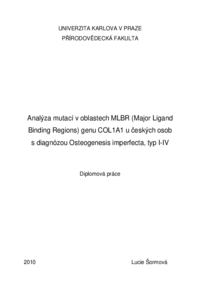Analýza mutací v oblastech MLBR /Major Ligand Binding Regions/ genu COL1A1 u českých osob s diagnózou Osteogenesis imperfecta, typ I-IV.
Mutation Analysis in MLBR /Major Ligand Binding Regions/ of COL1A1 gene of the Czech Individuals with Osteogenesis Imperfecta, Type I-IV Diagnosis.
diplomová práce (OBHÁJENO)

Zobrazit/
Trvalý odkaz
http://hdl.handle.net/20.500.11956/37596Identifikátory
SIS: 73826
Katalog UK: 990012704640106986
Kolekce
- Kvalifikační práce [21484]
Autor
Vedoucí práce
Oponent práce
Včelák, Josef
Fakulta / součást
Přírodovědecká fakulta
Obor
Antropologie a genetika člověka
Katedra / ústav / klinika
Katedra antropologie a genetiky člověka
Datum obhajoby
14. 9. 2010
Nakladatel
Univerzita Karlova, Přírodovědecká fakultaJazyk
Čeština
Známka
Velmi dobře
Klíčová slova (česky)
Osteogenesis imperfecta, COL1A1, kolagen typ I, kolagenopatie, mutace, česká populaceKlíčová slova (anglicky)
Osteogenesis imperfecta, COL1A1, collagen type I, collagenopathies, mutations, the Czech populationOsteogenesis imperfecta je dědičné onemocnění člověka způsobené především mutacemi genů kolagenu typ I, COL1A1 a COL1A2. Tyto mutace svým klinickým dopadem postihují zejména pohybový aparát. Onemocnění je charakteristické křehkými kostmi, deformacemi a vyšší četností zlomenin. Jedná se o poruchu vyskytující se ve všech populacích bez ohledu na věk, pohlaví, národnost či etnickou skupinu. Incidence této choroby je 1 : 16 - 20 000 narozených dětí. V současné době je popisováno devět klinicky odlišných forem Osteogenesis imperfecta, přičemž pouze první čtyři typy, OI typ I-IV, mají svou genetickou podstatu v mutacích genů kolagenu typ I. V rámci těchto devíti typů OI rozlišujeme lehké a závažné formy onemocnění. Za letální formy označujeme typy II a III, neboť u těchto forem dochází k úmrtí již během prenatálního vývoje či prvních dnů života postiženého jedince. Mezi charakteristické znaky kolagenních forem OI řadíme zvýšenou incidenci fraktur, deformace kostí, modré bělmo, nedoslýchavost, poruchu tvorby dentinu či podprůměrný vzrůst (Marini, 2010). Diplomová práce je zaměřena na popis klinických forem, zkoumání molekulární podstaty vzniku onemocnění a zjištění vztahu mezi typem a pozicí mutace a výsledným klinickým dopadem na postižené jedince. V rámci této práce byla provedena genetická analýza...
Osteogenesis imperfecta is an inherited disorder caused mainly by collagen type I genes mutations, COL1A1 and COL1A2. These mutations affect especially connective tissue. Disease is characterized by fragile bones, deformations and increased frequency of fractures. It's worldwide extensive disorder regardless of age, sex, nationality or races. The incidence is 1: 16 - 20 000 births. Currently, we described nine clinically distinct forms of Osteogenesis imperfecta. Only the first four types OI, type I-IV, are caused by collagen type I genes mutations . In these nine types there are distinguished mild and severe forms. Type II and III are lethal forms, death occur offen during prenatal period or in the first days of the life affected individuals. Characteristic clinical features of collagen forms OI are an increased incidence of fractures, deformations of bones, blue sclera, hearing loss, Dentinogenesis imperfecta small or subnormal growth (Marini, 2010). This study alignment is mainly the description of the clinical forms, exploring the molecular basis of disease and determine the relationship between the type and position of the mutation and the resulting phenotype of affected individuals. We have analysed exons 31-40, including associated non-coding regions, of the COL1A1 gene (so-called MLBR =...
